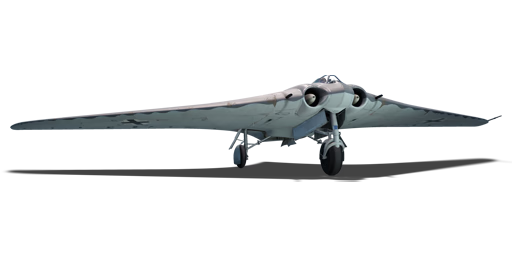



The Horten Ho 229, also known by its production designation as the Gotha Go 229, is a jet-powered flying wing aircraft designed by the Horten brothers in Germany during the later stages of World War II. It was originally designed in 1943 in response to the RLM's requirements for a "3×1000" fast bomber; an aircraft capable of carrying up to 1,000 kg of bombs, with a range of 1,000 km, and a speed up to 1,000 km/h. Development of the Ho 229 was later reassigned to the Emergency Fighter Program in 1944, which aimed to produce cheap and simple fighters that could defend the Reich from Allied bombers. To reduce costs, Gothaer simplified the design, most notably redesigning the wings to be made of a mixture of plywood panels glued with charcoal and sawdust mixture and attached it to a steel "fuselage" mid-section. The Ho 229 V3 was the third prototype of the Ho 229, and was intended to be the testbed for the first production model, capable of carrying two 30 mm cannons and, later on, possibly a 1,000 kg bomb load. The Ho 229 V3 was never completed, as it was captured by US forces in April 1945 at the Gothaer Waggonfabrik factory. The Ho 229 V3 was the only surviving example of the Ho 229, and it is currently on display at the Smithsonian National Air and Space Museum in Washington, D.C.
The Ho 229 V3 was introduced in Update 1.43. It is the first jet in the "Zerstörer" tech tree of the Luftwaffe and currently comes before the G.91 R/3. Ironically, it goes against much of the doctrine set by the previous planes, favouring speed and manoeuvrability over armament and durability. Something that will immediately stand out with the Ho 229 V3 is how incredibly manoeuvrable it is compared to most other jet fighters. The Ho 229 V3 can almost quite literally turn on a dime and can even in some circumstances out-turn late super props such as the P-51H if manoeuvred correctly. However, if its manoeuvrability is used to its full extent, it also causes the plane to bleed speed at a crippling rate, making a sustained turn fight impossible to win. As such, it is advised to use the Ho 229 V3 as a Boom & Zoom fighter in order to maintain airspeed and altitude. Remember that jet engines' efficiency is directly proportional to the IAS, due to the increased air intake, meaning the Ho 229 V3 will be accelerating very slowly between 0-500 km/h, but beyond will be able to outrun any propeller-driven aircraft.
flaps
flaps
flaps
brake
| Belt | Belt filling | Armor penetration (mm) at a distance: | |||||
|---|---|---|---|---|---|---|---|
| 10 m | 100 m | 500 m | 1000 m | 1500 m | 2000 m | ||
| HEI-T/SAPHEI-T/AP-I | 58 | 55 | 44 | 33 | 25 | 19 | |
| HVAP-T/SAPHEI-T/HVAP-T/AP-I | 77 | 74 | 61 | 47 | 37 | 29 | |
| HEI-T/HEI-T/HEI-T/SAPHEI-T | 38 | 36 | 28 | 20 | 15 | 11 | |
| AP-I | 58 | 55 | 44 | 33 | 25 | 19 | |












Flight performance | |
|---|---|
Survivability |
|---|
Weaponry |
|---|